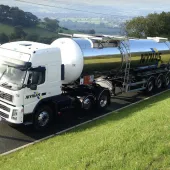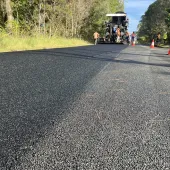Performance Benefits and Versatility of Premium Polymer-modified Bitumens

First published in the July 2020 issue of Quarry Management as Sustainability through Durability
Rick Ashton, market development manager at Total UK – Bitumen Division, explores the performance benefits and versatility of premium polymer-modified bitumens (PMBs) and why Total Styrelf eXtreme 100 is the ‘Swiss Army Knife’ of PMBs for producers
The coronavirus crisis has changed the entire landscape of the nation’s economy and its outlook on purchasing essential materials. For basics such as household goods, many people are avoiding visiting shops and supermarkets and are instead doing their shopping online and using delivery or click-and-collect services.
This change in habits has had a dramatic effect on purchasing strategies. Being in this situation focuses the mind on the importance of getting the weekly ‘big shop’ right first time. Ensuring nothing is missed, eg essential weekend items such as Friday night wine and chocolate, is a huge responsibility for the ‘head of household procurement’ who knows there will be severe repercussions from the rest of the family if anything is overlooked!
Commodities such as milk and potatoes are staples and are mainly bought on cost, however differentiating between premium products is a more complex matter. Why does one coffee or olive oil cost twice as much as another, and what factors influence which one we buy?
In a way, our grandparents had a similar if more pressing issue with rationing and became very good at making one thing perform a variety of tasks. On an industrial scale, procurement of the right products has always been a balance of cost versus value and how to get the most worth from materials.
Category considerations
Applying this to bitumen for asphalt production, there are two major categories to consider – the commodity category (penetration grades) and the premium category (polymer-modified bitumen – PMB). Penetration grades are the potatoes, so as long as specification is complied with, buyers only really make purchasing decisions based on cost and factors such as one supplier’s service levels over another. PMBs, on the other hand, bring more complex factors to the procurement decision-making process.
PMB performance can vary significantly across the broad spectrum of materials available on the market today. Some basic physically blended products, in modification terms, could be described by cynics as ‘homeopathic’ PMBs. Polymer content can be so low that it brings little benefit to the bitumen, offering minimal enhancement of physical properties from the base penetration grades. This can be seen by looking at the delta in softening points, and elastic recovery and rheology between the unmodified product and the modified PMB.
At the other end of the scale, highly modified PMBs, as required for Transport for Scotland, TS2010 stone-mastic asphalts (SMAs) and specialist applications such as stress-absorbing membranes, completely change bitumen behaviour in terms of viscoelastic and thermoplastic performance characteristics.
The only effective way to compare the various products is to benchmark them in individual performance categories where EN14023 performance characterization can be used to good effect.
A good methodology is to look at ring and ball softening points in relation to base penetration – the point at which bitumen turns from a solid to a liquid as temperature increases.
A highly modified product such as Total Styrelf eXtreme 100 has a softening point >75°C, as required by the TS2010 specification. This high softening point is still achieved, despite the soft base penetration range of 75/130, indicating a high level of modification as the softening point has increased by c.35°C post modification.
A much less modified PMB with similar base penetration could have a softening point as low as 50°C, similar to an unmodified pen grade. Road surface temperatures can exceed 60°C in UK summers, so this can be a critical factor in material stability. This would also be demonstrated in the scale of the ‘plasticity range’ or the difference between low-temperature brittleness (Fraas Point) and the softening point. For a premium-grade material this range can be as high as 100°C. For the lower-grade PMBs this would be more like 60°C. This characteristic can be a key indicator of a PMB’s level of modification and gives some indication of where the cost versus value starts to become apparent. It is necessary to compare apples with apples, or caviar with potatoes in this case!
The panacea for highway durability
Performance differences in terms of durability between a premium-grade and basic PMB also should not be underestimated. In recent years, Total UK – Bitumen Division has been examining factors leading to durable asphalt when PMB is specified. One specific area which is highly discriminating for benchmarking performance is fatigue resistance or in practical terms – delaying the onset of cracking. Using a uniform material such as a sand carpet to benchmark offers a sample with as little grading variance as possible. Total have used a modified Texas Overlay Test to rank materials in terms of resistance to cracking on simulated concrete slab joints. Starting with commodity 40/60 penetration bitumen, then moving through the Styrelf portfolio from the least to the most modified, Total Styrelf X, Total Styrelf eXcel and finally Total Styrelf eXtreme, a multi-fold increase in cycles to failure is observed, clearly differentiating the basic from the premium products.
Figure 1 illustrates that the pen grade samples failed after just over 200 cycles, whereas the Total Styrelf eXtreme 100 samples did not fail after 1,000 cycles and still retained 20% of their original stiffness.
This all points to premium PMBs being the panacea to all highway durability issues. However, the difficulty comes not just in explaining engineering value vs pricing differentials, but also in manufacturing logistics. Asphalt plants rarely have more than one PMB storage tank.
With so many varied asphalt specifications, selection of the optimum grade, which avoids wastage and meets the required standards, becomes very difficult. A basic PMB may produce a thin surfacing compliant with CL942 specification. This PMB may not have the level of modification required to produce a hot-rolled asphalt for a WT2 specification at 60°C or a premium SMA specification. The asphalt producer may have to waste basic-grade PMB to make tank ullage for a more premium product, depending on specification requirements.
The best solution would be a versatile PMB grade that could be procured, tanked and manufactured to meet most asphalt specifications, while offering the ability for proprietary value-added products to be produced from the same storage tank.
Versatility and performance
This is where the value of Total Styrelf eXtreme 100 can become apparent to an asphalt producer. This PMB can produce highly durable, slow-ageing thin-surface courses, resisting high-temperature flushing, low-temperature fretting and age-related ravelling, while offering high levels of fatigue resistance throughout its life.
Total Styrelf eXtreme 100 can also produce WT2 hot-rolled asphalts with resistance to deformation in high temperatures, premium SMAs complying with local or TS2010 specifications, and even SAMIs – stress-absorbing material interlayers. Essentially, it is a one-size-fits-all PMB.
For the producer, this PMB’s cross-linked polymerization provides another key benefit, that of enhanced storage stability.
Total Styrelf is proven to still be compliant after up to 100 days in storage, whereas more basic physical blends require quality checks post 28 days in storage. This is a key benefit when premium products are produced infrequently, and lesser products can degrade in storage within a month.
This binder is considered by Total to be both a production enabler and a valuable tool in the highways asset manager’s arsenal of solutions to achieve ‘sustainability through durability.’
Slower ageing and deceleration of polymer deterioration allows predictable maintenance modelling. This, in turn, enables long-term predictable depreciation modelling and budgeting. This significantly reduces reactive maintenance, which is proven to be negative to network operators’ long-term financial planning. Furthermore, this predictability helps the case to secure funding from central government. Improved asset management equals improved funding, as this is a circular economic cycle that can be achieved through material durability.
Total Styrelf eXtreme 100 is like a Swiss Army Knife in the back pocket of smart producers. The ability to manufacture a myriad of asphalt designs using one specific grade reduces waste and the anxiety associated with limited storage capacity. With an ever-increasing portfolio of special products to supply to a sector hungry for innovation, this PMB is an enabling solution for customers.
But the asphalt market is not only about highways, there are also civil and military airfields, racetracks and bridge structures that all bring their own unique challenges. The more innovative the applications that customers bring to Total for product development, the more the answer comes back the same, that Total Styrelf eXtreme 100 fits that application.
Cost versus value
Having made the case for durability and the storage benefits of premium-grade PMB, how are these benefits explained to the end client who is ultimately the gatekeeper to decision making on material selection? This could be the local authority highways asset managers, specifiers or designers in large consultancies.
A cost vs value model is required. Total are constantly developing longer-lasting, slower-ageing Styrelf products. The independent, Swiss, Lavoc long-term ageing study on bitumen has already been well documented in the pages of this publication (see QM June 2015 and June 2017 editions). It demonstrated how cross-linked Styrelf outlasted all other PMBs and unmodified binders in UV and oxidative ageing over a 20-year period. The lessons learned here have been applied in the continuous development of slow-ageing Total Styrelf PMBs and are now being applied to whole life-cycle modelling for predictive deterioration modelling and enhanced asset management.
Figure 2 illustrates the significantly reduced ageing behaviour (changes in properties) of Styrelf eXcel compared with pen grade bitumen.
Life-cycle analysis shows a 10% improvement in durability can remove one maintenance intervention in a carriageways design life based on an 80msa (million standard axles) design. Removing one maintenance intervention easily negates the cost differential between basic and premium products. Reduced disruption to the public, environmental benefits, improved productivity and the economic impact of reduced roadworks are significant. These benefits are becoming key performance indicators to network operators both at local road, major and strategic network levels. The pressure to cut costs and use cheaper materials is understandable, but the reality is that a road that is 10% cheaper to build and only lasts 70% as long as a more durable design is not good asset management or value for the authority and, ultimately, the taxpayer.
To enhance these already considerable benefits, new advances in warm-mix asphalt innovations have allowed Total to offer the entire Styrelf portfolio as warm-mix binders. This allows a temperature reduction of up to 40°C. These binders are designated Total Styrelf Eco2 and form part of Total’s Eco Solutions range, which covers all grades of Styrelf from the basic X range, through eXcel and up to eXtreme levels of modification.
Warm-mix benefits
With a lower mix temperature, faster contracting is possible, allowing thicker layers to be placed or multiple layers to be placed in one shift. On-site productivity can be improved by more than 20% due to the fact less cooling time is required before trafficking. Overall air quality is improved compared with hot mix by reducing all emissions by up to 40% and CO2 by up to 30%. These are all important factors, particularly in ultra-low emission zones in cities such as London. Health and safety benefits include improved visibility in roadworks for workers and passing traffic, due to steam reduction. Schemes as large as 10,000 tonnes have been completed using this technique, such as the A66 Penrith to Kirkby Stephen. The collaboration between all the parties involved – Total, Tarmac and Highways England – illustrated that when all stakeholders work together and material selection is optimized, the outcome is assured to be a success. A short film about this scheme can be viewed on YouTube (https://youtu.be/VLYgrVw-HQU). Total actively encourage stakeholder engagement with customers and end clients to assist understanding of the key factors in material selection and application.
With more than 30 years’ continuous development, Total Styrelf remains at the cutting-edge of polymer-modified bitumen technology. The focus for Styrelf development moving forward will be on achieving even slower ageing and lower-temperature application. The ethos remains on ‘sustainability through durability’ throughout the entire Total Bitumen Division solutions portfolio.
About the author
Rick Ashton is market development manager for Total UK – Bitumen Division. He has worked in the quarrying and asphalt sector for 31 years in both technical and commercial roles, and has been in his current role at Total UK for nine years. Rick is a member of the Chartered Institution of Highways & Transportation and the Institute of Quarrying and is also chairman of the Pennine branch of the Institute of Asphalt Technology.
- Subscribe to Quarry Management, the monthly journal for the mineral products industry, to read articles before they appear on Agg-Net.com








